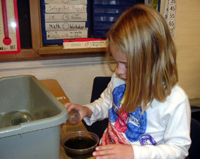Documentation Examples > Documentation Exhibition
Beginning the Journey: Learning through teacher and student documentation
School: Wickliffe Progressive Community School, Columbus, OH
2. Solids and Liquids Project
Dialogue between teacher and student:
Mrs. W: What did you discover?
Drew: The science project was fun. And I am looking forward to the mystery.
Mrs. W: What mystery?
Drew: The mystery between the vial and the large cup.
Mrs. W: What clues do you have?
Drew: They were filled up by the same vial so they were probably the same.
Mrs. W: So, if you know they were filled up with the same vial, then why is the mystery not solved?
Drew: We haven't come to agreement yet. After our agreement it will be settled.
Here are other children?s ideas and observations about which container has more liquid:
"The big one looks bigger - It's not the tall one is."
"The skinny container is larger because the water came up?"
"The big one has more because it?s a bigger one and doesn't have much on the sides."
"All of them are different."
"When you pour it in it doesn't have enough room and goes higher on the sides."
"The water spreads out in the wide jar."
Sharing With Colleagues
Clearly the children did not come to an "agreement" to settle the "mystery" that Drew referred to. At this point this project was shared, using the collaborative assessment protocol, with our Wickliffe Inquiry Group (WIG) using the collaborative assessment protocol. My goal in sharing with colleagues was to help me generate classroom experiences I could provide to challenge those children who believed that the tall, thin container held more liquid then the short, wide container.
Children's writing, drawing, photos and video provided multiple lenses for the WIG to view students' understandings when they were sharing their theories and discoveries with each other.
Sabrina's Reflection
Using the collaborative assessment protocol during a staff retreat helped generate classroom experiences we could provide to challenge those children who believed that the tall thin container held more liquid than the short wide container.



